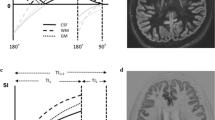Abstract
We assessed possible advantages of the use of fluid-attenuated inversion-recovery (FLAIR) sequences with magnetisation-transfer contrast (MTC) over conventional FLAIR images. We carried out cranial MRI at 1 tesla on 50 patients with both sequences. In nine patients with multiple sclerosis (MS) we performed a quantitative comparison of the two sequences, looking at the contrast-to-noise ratio between lesions and normal white matter and counting the number of lesions shown using each method. A qualitative comparison on all patients consisted of the analysis of the appearance of the normal parenchyma, of any lesions, and of artefacts, with particular reference to cerebrospinal fluid (CSF) motion artefacts. The quantitative analysis showed no meaningful difference between the two sequences. The cerebral parenchyma and lesions appeared substantially the same with both techniques. With FLAIR MTC there was a clear, and consistent reduction in CSF motion artefacts. FLAIR MTC sequences can usefully be used in place of the conventional sequence at 1 tesla.

Similar content being viewed by others
References
Finelli DA, Hurst GC, Gullapali RP, Bellon EM (1994) Improved contrast of enhancing brain lesions on postgadolinium, T1-weighted spin-echo images with use of magnetization transfer. Radiology 190: 553–559
Mehta RC, Pike GB, Haros SP, Enzmann DR (1995) Central nervous system tumor, infection, and infarction: detection with gadolinium-enhanced magnetization transfer MR imaging. Radiology 195: 41–46
Edelman RR, Ahn SS, Chien D, et al (1992) Improved time-of-flight MR angiography of the brain with magnetization transfer contrast. Radiology 184: 395–399
Dousset V, Franconi JM, Degreze P, Balderrama J, Lexa F, Caillé JM (1994) Use of magnetization transfer contrast to improve cerebral 3D MR angiography. Neuroradiology 36: 188–192
Filippi M, Rocca MA, Mastronardo G, Comi G (1999) Lesion load measurements in multiple sclerosis: the effect of incorporating magnetization transfer contrast in a fast-FLAIR sequence. Magn Res Imaging 17: 459–461
Bakshi R, Caruthers SD, Janardhan V, Wasay M (2000) Intraventricular CSF pulsation artifact on fast fluid-attenuated inversion-recovery MR images: analysis of 100 consecutive normal studies. AJNR 21: 503–508
Tanaka N, Abe T, Kojima K, Nishimura H, Hayabuchi N (2000) Applicability and advantages of flow artifact-insensitive fluid-attenuated inversion-recovery MR sequences for imaging the posterior fossa. AJNR 21: 1095–1098
Hajnal JV, Oatridge A, Herlihy AH, Bydder GM (2001) Reduction of CSF artifacts on FLAIR images by using adiabatic inversion pulses. AJNR 22: 317–322
Oatridge A, Curati WL, Herlihy AH, et al (2001) Evaluation of a FLAIR sequence designed to reduce CSF and blood flow artifacts by use of k-space reordered by inversion time at each slice position (KRISP) in high grade gliomas of the brain. J Comput Assist Tomogr 25: 251–256
Herlihy AH, Hajnal JV, Curati WL, Virji N, Oatridge A, Puri BK, Bydder GM (2001) Reduction of CSF and blood flow artifacts on FLAIR images of the brain with k-space reordered by inversion time at each slice position (KRISP). AJNR 22: 896–204
Author information
Authors and Affiliations
Corresponding author
Rights and permissions
About this article
Cite this article
Aprile, I., Scapeccia, M., Principi, M. et al. The effect of magnetisation transfer contrast on cerebrospinal fluid on motion artefacts on fluid-attenuated inversion-recovery images. Neuroradiology 45, 893–895 (2003). https://doi.org/10.1007/s00234-003-1092-z
Received:
Accepted:
Published:
Issue Date:
DOI: https://doi.org/10.1007/s00234-003-1092-z




